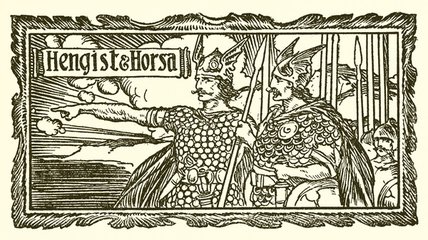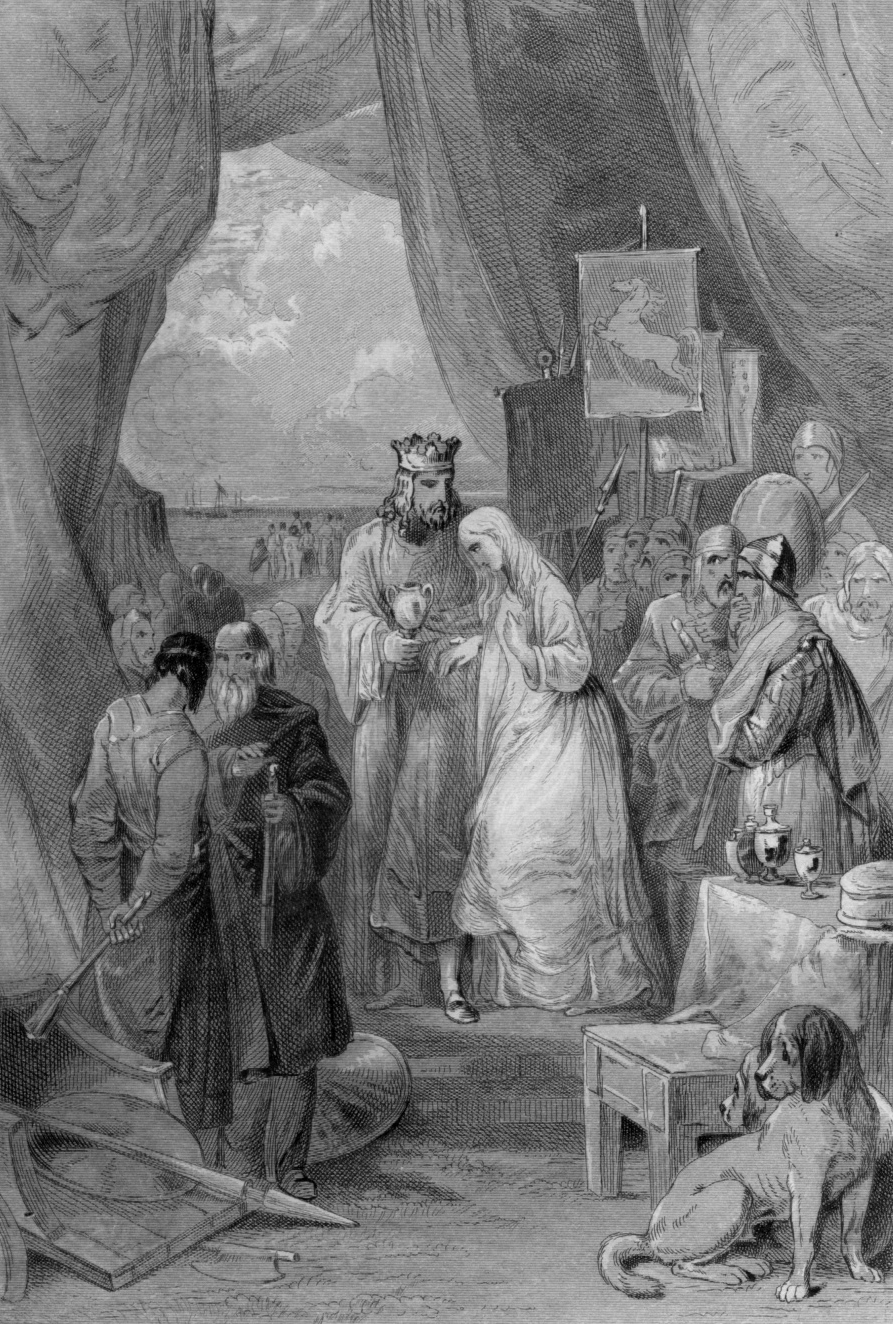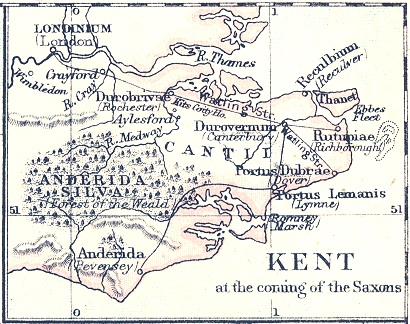|
Rowena
Rowena in the Matter of Britain was the daughter of the purported Anglo-Saxon chief Hengist and wife of Vortigern, "King of the Britons". Presented as a beautiful ''femme fatale'', she won her people the Kingdom of Kent through her treacherous seduction of Vortigern. Contemporary sources are nearly non-existent, so it is impossible to know if she actually existed. Name The name "Rowena" does not appear in Old English sources such as Bede's ''Ecclesiastical History of the English People'' and the ''Anglo-Saxon Chronicle''. It was first recorded by Geoffrey of Monmouth in his 12th-century ''Historia Regum Britanniae'' (in various spellings, including Ronwen, Renwein, and Romwenna), and may represent a Medieval Latin corruption of some lost Old English or other Germanic name. Another possibility is that it comes from the Brittonic languages, where the name becomes Welsh ''Rhonwen''; this could be connected to the word "horsehair" ( cy, rhawn), which might be significant given he ... [...More Info...] [...Related Items...] OR: [Wikipedia] [Google] [Baidu] |
Hengist And Horsa
Hengist and Horsa are Germanic brothers said to have led the Angles, Saxons and Jutes in their invasion of Britain in the 5th century. Tradition lists Hengist as the first of the Jutish kings of Kent. Most modern scholarly consensus now regards Hengist and Horsa to be mythical figures, and much scholarship has emphasised the likelihood of this based on their alliterative animal names, the seemingly constructed nature of their genealogy, and the unknowable quality of the earliest sources of information for their reports in the works of Bede.Halsall (2013:60-62). Their later detailed representation in texts such as the Anglo-Saxon Chronicle can tell us more about ninth-century attitudes to the past than anything about the time in which they are said to have existed.Yorke (1993).Harland (2021:32). According to early sources, Hengist and Horsa arrived in Britain at Ebbsfleet on the Isle of Thanet. For a time, they served as mercenaries for Vortigern, King of the Britons, but lat ... [...More Info...] [...Related Items...] OR: [Wikipedia] [Google] [Baidu] |
Vortigern
Vortigern (; owl, Guorthigirn, ; cy, Gwrtheyrn; ang, Wyrtgeorn; Old Breton: ''Gurdiern'', ''Gurthiern''; gle, Foirtchern; la, Vortigernus, , , etc.), also spelled Vortiger, Vortigan, Voertigern and Vortigen, was a 5th-century warlord in Britain, known perhaps as a king of the Britons or at least connoted as such in the writings of Bede and Gildas. His existence is contested by scholars and information about him is obscure. He may have been the "superbus tyrannus" said to have invited Hengist and Horsa to aid him in fighting the Picts and the Scots, whereupon they revolted, killing his son in the process and forming the Kingdom of Kent. It is said that he took refuge in North Wales, and that his grave was in Dyfed or the Llŷn Peninsula. Gildas later denigrated Vortigern for his misjudgement and also blamed him for the loss of Britain. He is cited at the beginning of the genealogy of the early Kings of Powys. Medieval accounts Gildas The 6th-century cleric and historia ... [...More Info...] [...Related Items...] OR: [Wikipedia] [Google] [Baidu] |
Hamilton Vortigern & Rowena
Hamilton may refer to: People * Hamilton (name), a common British surname and occasional given name, usually of Scottish origin, including a list of persons with the surname ** The Duke of Hamilton, the premier peer of Scotland ** Lord Hamilton (other), several Scottish, Irish and British peers, and some members of the judiciary, who may be referred to simply as ''Hamilton'' ** Clan Hamilton, an ancient Scottish kindred * Alexander Hamilton (1755–1804), first U.S. Secretary of the Treasury and one of the Founding Fathers of the United States * Lewis Hamilton, a British Formula One driver *William Rowan Hamilton (1805–1865), Irish physicist, astronomer, and mathematician for whom ''Hamiltonian mechanics'' is named *Hamílton (footballer) (born 1980), Togolese footballer Places Australia * Hamilton, New South Wales, suburb of Newcastle * Hamilton Hill, Western Australia, suburb of Perth * Hamilton, South Australia * Hamilton, Tasmania * Hamilton, Victoria Queensl ... [...More Info...] [...Related Items...] OR: [Wikipedia] [Google] [Baidu] |
Germanic Languages
The Germanic languages are a branch of the Indo-European language family spoken natively by a population of about 515 million people mainly in Europe, North America, Oceania and Southern Africa. The most widely spoken Germanic language, English, is also the world's most widely spoken language with an estimated 2 billion speakers. All Germanic languages are derived from Proto-Germanic, spoken in Iron Age Scandinavia. The West Germanic languages include the three most widely spoken Germanic languages: English with around 360–400 million native speakers; German language, German, with over 100 million native speakers; and Dutch language, Dutch, with 24 million native speakers. Other West Germanic languages include Afrikaans, an offshoot of Dutch, with over 7.1 million native speakers; Low German, considered a separate collection of Standard language, unstandardized dialects, with roughly 4.35–7.15 million native speakers and probably 6.7–10 million people who can understand ... [...More Info...] [...Related Items...] OR: [Wikipedia] [Google] [Baidu] |
List Of Legendary Kings Of Britain
The following list of legendary kings of Britain derives predominantly from Geoffrey of Monmouth's circa 1136 work ''Historia Regum Britanniae'' ("the History of the Kings of Britain"). Geoffrey constructed a largely fictional history for the Britons (ancestors of the Welsh, the Cornish and the Bretons), partly based on the work of earlier medieval historians like Gildas, Nennius and Bede, partly from Welsh genealogies and saints' lives, partly from sources now lost and unidentifiable, and partly from his own imagination (see bibliography). Several of his kings are based on genuine historical figures, but appear in unhistorical narratives. A number of Middle Welsh versions of Geoffrey's ''Historia'' exist. All post-date Geoffrey's text, but may give us some insight into any native traditions Geoffrey may have drawn on. Geoffrey's narrative begins with the exiled Trojan prince Brutus, after whom Britain is supposedly named, a tradition previously recorded in less elaborate form ... [...More Info...] [...Related Items...] OR: [Wikipedia] [Google] [Baidu] |
North Wales
, area_land_km2 = 6,172 , postal_code_type = Postcode , postal_code = LL, CH, SY , image_map1 = Wales North Wales locator map.svg , map_caption1 = Six principal areas of Wales commonly defined to be North Wales, for policing, fire and rescue, health and regional economy. North Wales ( cy, Gogledd Cymru) is a region of Wales, encompassing its northernmost areas. It borders Mid Wales to the south, England to the east, and the Irish Sea to the north and west. The area is highly mountainous and rural, with Snowdonia National Park ( and the Clwydian Range and Dee Valley (), known for its mountains, waterfalls and trails, wholly within the region. Its population is concentrated in the north-east and northern coastal areas, with significant Welsh-speaking populations in its western and rural areas. North Wales is imprecisely defined, lacking any exact definition or administrative structure. It is commonly defined adminis ... [...More Info...] [...Related Items...] OR: [Wikipedia] [Google] [Baidu] |
Anglo-Saxon Settlement Of Britain
The Anglo-Saxon settlement of Britain is the process which changed the language and culture of most of what became England from Romano-British to Germanic peoples, Germanic. The Germanic-speakers in Britain, themselves of diverse origins, eventually developed a common cultural identity as Anglo-Saxons. This process principally occurred from the mid-fifth to early seventh centuries, following the Roman withdrawal from Britain, end of Roman rule in Britain around the year 410. The settlement was followed by the establishment of the Heptarchy, Anglo-Saxon kingdoms in the south and east of Great Britain, Britain, later followed by the rest of modern England, and the south-east of modern Scotland. The available evidence includes the scant contemporary and near-contemporary written record, archaeological and genetic information. The few literary sources tell of hostility between incomers and natives. They describe violence, destruction, massacre, and the flight of the Romano-Britis ... [...More Info...] [...Related Items...] OR: [Wikipedia] [Google] [Baidu] |
Devil
A devil is the personification of evil as it is conceived in various cultures and religious traditions. It is seen as the objectification of a hostile and destructive force. Jeffrey Burton Russell states that the different conceptions of the devil can be summed up as 1) a principle of evil independent from God, 2) an aspect of God, 3) a created being turning evil (a ''fallen angel''), and 4) a symbol of human evil. Each tradition, culture, and religion with a devil in its mythos offers a different lens on manifestations of evil.Jeffrey Burton Russell, ''The Devil: Perceptions of Evil from Antiquity to Primitive Christianity'', Cornell University Press 1987 , pp. 41–75 The history of these perspectives intertwines with theology, mythology, psychiatry, art, and literature developing independently within each of the traditions. It occurs historically in many contexts and cultures, and is given many different names— Satan, Lucifer, Beelzebub, Mephistopheles, Iblis—and at ... [...More Info...] [...Related Items...] OR: [Wikipedia] [Google] [Baidu] |
Magnus Maximus
Magnus Maximus (; cy, Macsen Wledig ; died 8 August 388) was Roman emperor of the Western Roman Empire from 383 to 388. He usurped the throne from emperor Gratian in 383 through negotiation with emperor Theodosius I. He was made emperor in Britannia and Gaul the next year while Gratian's brother Valentinian II retained Italy, Pannonia, Hispania, and Africa. In 387, Maximus's ambitions led him to invade Italy, resulting in his defeat by Theodosius I at the Battle of Poetovio in 388. In the view of some historians, his death marked the end of direct imperial presence in Northern Gaul and Britain. Life Birth, army career Maximus was born in Gallaecia, on the estates of Count Theodosius (the Elder) of the Theodosian dynasty, to whom he claimed to be related.J. B. Bury ed. (1924)''The Cambridge Medieval History'' p. 238 Maximus was a distinguished general; he was probably a junior officer in Britain in 368, during the quelling of the Great Conspiracy. He served under Count Theodos ... [...More Info...] [...Related Items...] OR: [Wikipedia] [Google] [Baidu] |
Isle Of Thanet
The Isle of Thanet () is a peninsula forming the easternmost part of Kent, England. While in the past it was separated from the mainland by the Wantsum Channel, it is no longer an island. Archaeological remains testify to its settlement in ancient times. Today, it is a tourist destination, and has an active agricultural base. Etymology The island of Thanet is mentioned as ''Tonetic'' (c. AD 150; the TON- of this form was misread as TOΛI-, hence it appears as ''Toliatis'' in the surviving manuscripts of Ptolemy); ''Tanat's'' (3rd C AD, Solinus); ''Tanatos'' (AD 731); ''Tenid'' in 679BEAUREPAIRE and ''Tenet'' (e.g. charters of AD 679, 689 and thereafter); and the Old Welsh forms ''Tanet'' and ''Danet'', found in the ''Historia Brittonum'' (c. AD 829/30) and Armes Prydein (c. AD 930). Standard reference works for English place-names (such as Eilert Ekwall's ''Concise Oxford Dictionary of English Place-Names'') state the name ''Tanet'' is known to be Brythonic in origin. Common ... [...More Info...] [...Related Items...] OR: [Wikipedia] [Google] [Baidu] |
Nennius
Nennius – or Nemnius or Nemnivus – was a Welsh monk of the 9th century. He has traditionally been attributed with the authorship of the ''Historia Brittonum'', based on the prologue affixed to that work. This attribution is widely considered a secondary (10th-century) tradition. Nennius was a student of Elvodugus, commonly identified with the bishop Elfodd of Bangor, Gwynedd, Bangor who convinced British ecclesiastics to accept the Continental Easter controversy, dating for Easter, and who died in 809 according to the ''Annales Cambriae''. Nennius is believed to have lived in the area made up by Brecknockshire and Radnorshire in present-day Powys, Wales. Thus, he lived outside the Anglo-Saxon kingdoms, isolated by mountains in a rural society. Because of the lack of evidence concerning the life of Nennius, he has become the subject of legend himself. Welsh traditions include Nennius with Elbodug and others said to have escaped the massacre of Welsh monks by Ethelfrid in 613, ... [...More Info...] [...Related Items...] OR: [Wikipedia] [Google] [Baidu] |



.jpg)

_A_king%2C_possibly_Magnus_Maximus%2C_holding_a_sceptre.jpg)
